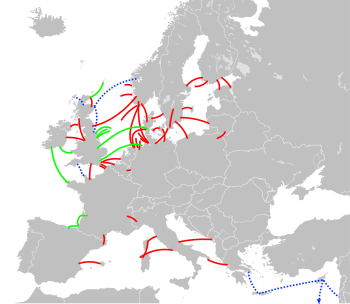High-voltage direct current
A high-voltage direct current (HVDC) is a transmission system which uses direct electric current (DC) to transmit electricity. It is more efficient over long distances than the usual high-voltage alternating current (HVAC).


History
changeHVDC was first demonstrated in 1882 in Germany. The technology was further developed during the 1930s in Sweden and Nazi Germany. Early commercial uses were in the Soviet Union and Sweden in 1951.
Technical details
changeConverter
changeThe converter in HVDC system converts AC electricity to DC electricity or vice versa. Converting AC to DC, it acts as a rectifier. Converting DC to AC, it acts as an inverter.
Types of HVDC converters:
- Line-commutated converters (LCC)
- Voltage-source converters (VSC)
Converter transformer
changeThe transformer at the converter station ensures that the station is isolated from the AC system connected to the HVDC system. It also provides the correct voltage level which will be converted to DC voltage.
Harmonic filter
changeBecause harmonics are always produced in electronic equipment, harmonic filters are used at the AC terminal of the converter. The DC harmonic filters can also be used at the DC line after the AC/DC conversion.
Electrode
changeThe electrode provides a ground return path for line current in monopolar configuration and unbalanced current in bipolar configuration.
Configurations
changeMonopole
changeIn HVDC monopole configuration, one of the terminals of the rectifier is connected to earth ground. The other terminal is connected to the transmission line. The earthed terminal may be connected to the corresponding connection at the inverting station by means of a second conductor.
Bipolar
changeIn HVDC bipolar configuration, a pair of conductors are used, each at a high potential with respect to ground in opposite polarity. The DC current flows via the positive pole and returns via the negative pole. The connection point between the positive and negative poles is grounded to the earth.
In this configuration, virtually no earth or neutral current is flowing. When one pole is broken, half of its transfer capability is still available.[1]
Back-to-Back
changeA back-to-back HVDC station is a HVDC station in which both converters are located within the same building area where the length of the DC line is being kept as short as possible.
Advantages and disadvantages
changeAdvantages
change- HVDC is more economical than HVAC to transmit large amounts of power over long distances
- HVDC lines need fewer conductors than HVAC lines
- HVDC lines use thinner conductors for the same amount of power transmitted in HVAC lines because HVDC lines don't have skin effects
- HVDC systems can transfer power between different AC frequency systems
- HVDC underground or submarine lines have no line capacitance like HVAC, hence need no load coils
Disadvantages
change- HVDC systems have lower availability than HVAC systems
- The required converter stations for HVDC are expensive and have limited overload capacity
- At shorter transmission line distances, HVDC converter stations will have more loss than HVAC systems of equivalent distances
- HVDC circuit breakers are harder to build than HVAC circuit breakers
- HVDC system operations require more spare parts to be kept than HVAC systems
- HVDC technology changes faster and is less standardized than HVAC technology
HVDC installations
changeReferences
change- ↑ "Archived copy" (PDF). Archived from the original (PDF) on 2022-05-20. Retrieved 2013-11-29.
{{cite web}}: CS1 maint: archived copy as title (link)